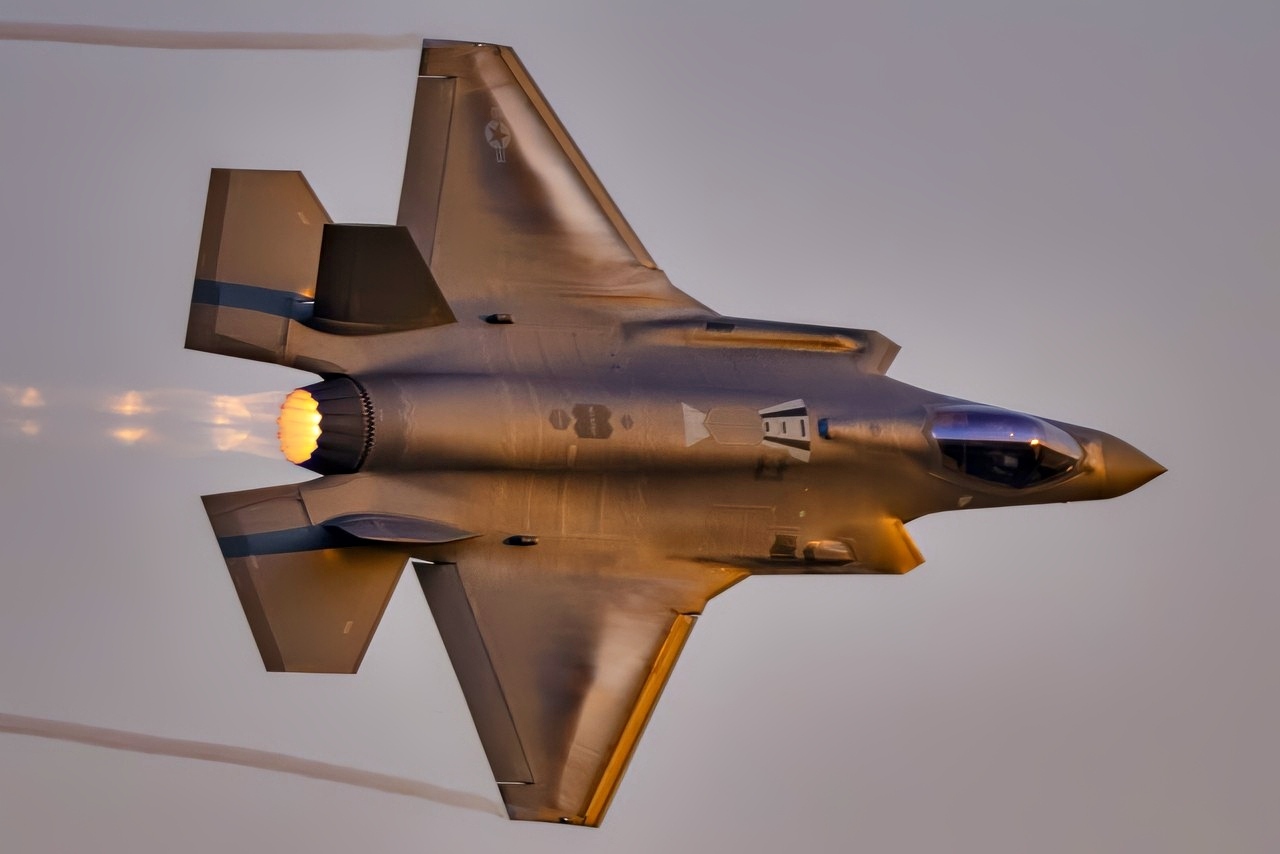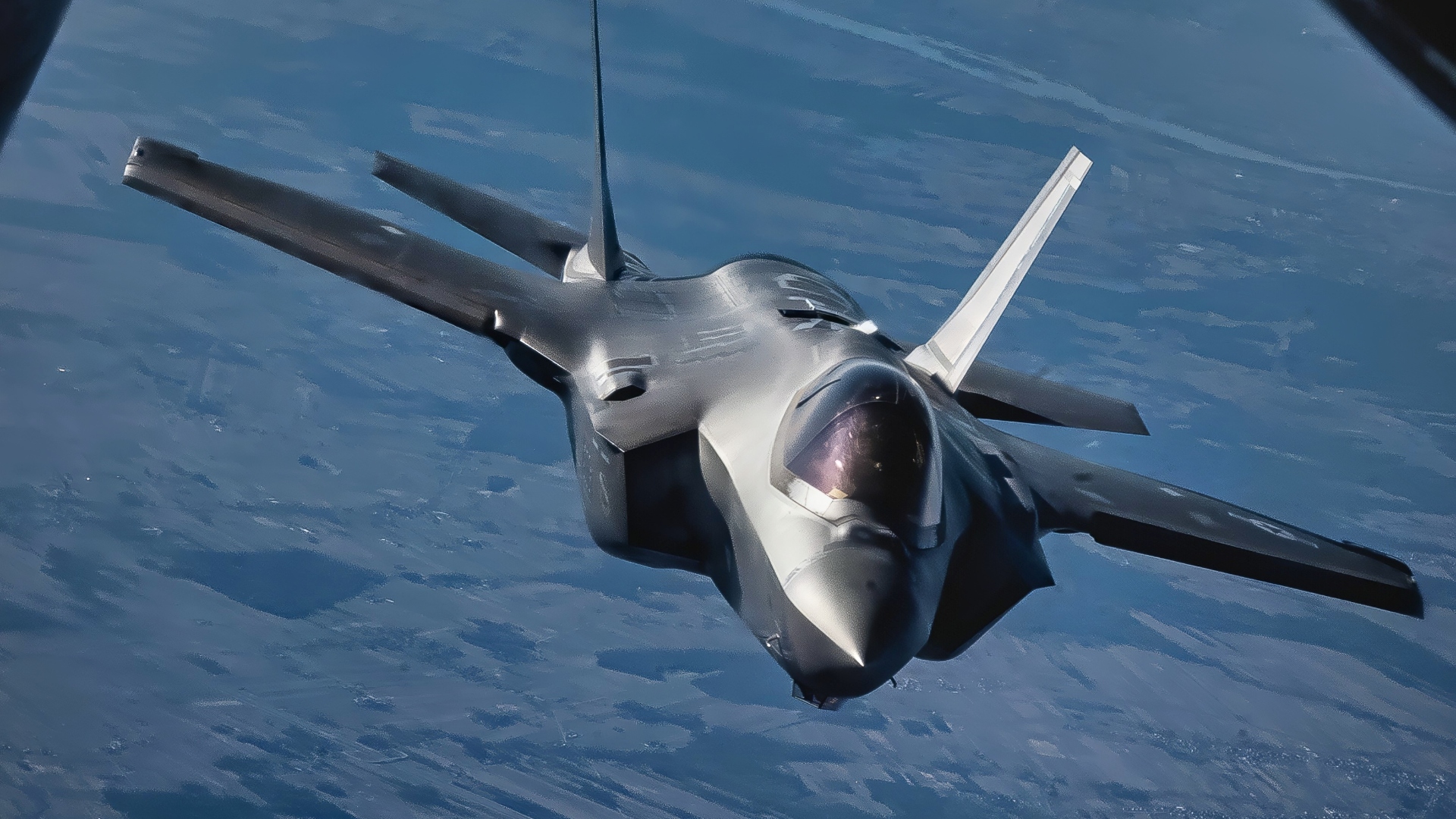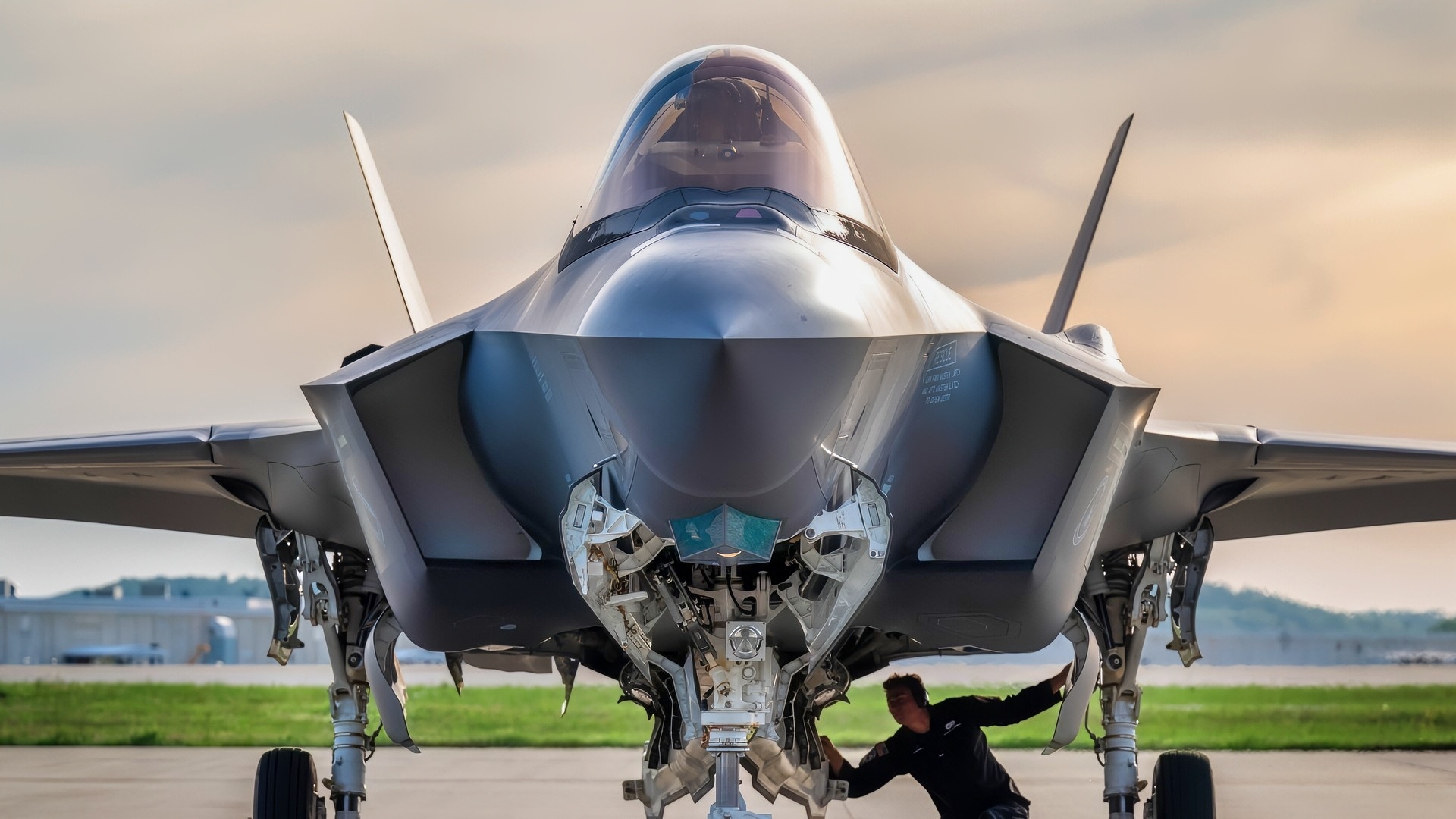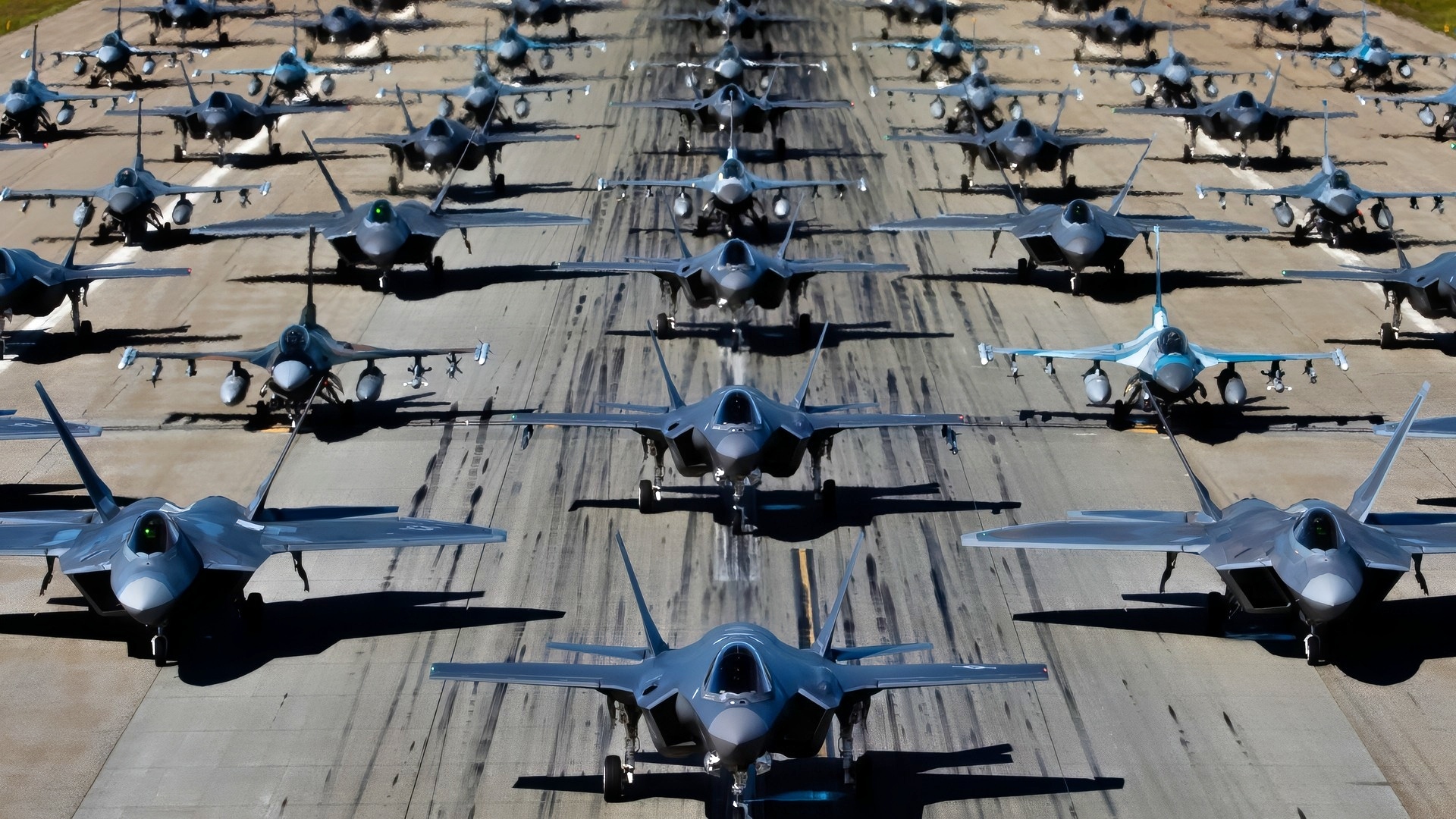Key Points and Summary – A strong case is made that Canada is already “all-in” on acquiring the F-35, with the final contract signing being a mere formality.
-The proof lies in irreversible actions already underway: Canadian pilot training slots are booked in the U.S. for 2026, and air bases like Cold Lake and Bagotville are undergoing major upgrades to F-35 standards.

A U.S. Air Force F-35A Lightning II assigned to the F-35A Lightning II Demonstration Team performs at the Capitol Air Show over Sacramento, California, July 15, 2024. Innovations such as the F135 Smart Stacking Tooling Enhancement developed by the OC-ALC mechanics and engineers have significantly improved the rotor assembly process, increasing precision and enhancing the depot’s ability to produce the engine that powers the F-35 Lightning II. (U.S. Air Force photo by Staff Sgt. Zachary Rufus)
-The F-35 is not a standalone purchase but the “keystone” of a broader, integrated strategy to modernize Canada’s Arctic and NORAD defenses.
-These concrete steps have made the political and operational cost of reversing the decision prohibitively high.
Canada Looks Set to Embrace F-35?
When Deputy Minister of Defense Stefani Beck recently said it was “full steam ahead” with Canada’s F-35 program, she wasn’t kidding.
Ottawa has already taken nearly all the necessary steps it would have taken had the final contract been signed: training slots at Luke Air Force Base are booked for 2026, aircraft are scheduled to begin arriving in Canada in 2028, and Cold Lake and Bagotville are being upgraded to F-35 standards.
The bases are installing mission-data facilities, security upgrades, weapons storage, and low-observable sustainment that only make sense if the jets are coming.
The choreography—personnel in allied training pipelines, concrete poured to a known delivery rhythm, and software and mission-data cycles aligned with partners—has raised the political and operational cost of reversal to the point where a final legal flourish is almost beside the point.
Sequencing First: The F-35 Program Is Already Moving
The clearest way to answer whether Canada is all-in is to follow the sequence. Programs that are still in the realm of rhetoric do not book pilots into allied syllabi years in advance. They do not harden hangars and hush houses to fifth-generation standards, build secure vaults for mission-data reprogramming, and schedule the arrival of support equipment to match known airframe deliveries.

The 388th Fighter Wing’s F-35 Lightning II fifth-generation fighter cruises in Eastern European airspace, Feb. 28, 2022, in support of NATO’s collective defense. U.S. Air Forces in Europe – Air Forces Africa’s ability to support and integrate with NATO’s air policing missions continually hardens the alliance’s solidarity, collective resolve, and ability to adapt to a dynamic warfighting environment. (U.S. Air Force photo by Airman 1st Class Edgar Grimaldo)
They certainly do not align their software update cycles to allied rhythms so that the jet flown on Wednesday is smarter than the jet flown on Monday. Canada has done all of this. The result is a machine in motion: people, places, processes, and platforms locked together in a cadence that transforms a policy preference into a military capability. By any practical test, that is not posturing; it is implementation.
The operational logic behind the sequencing is just as important as the milestones themselves. Training at Luke AFB immerses Royal Canadian Air Force pilots and maintainers in the same tactics, techniques, and mission-data culture that the United States and close allies use, which collapses the learning curve when aircraft begin operating from Canadian bases. Infrastructure upgrades at Cold Lake and Bagotville are not window dressing; they are preconditions for stealth sustainment, secure weapons handling, and classified data management. And a delivery schedule measured in calendar quarters disciplines the rest of the system. This is how serious air forces build capacity that works.
Procurement as Strategy, Not Shopping
The second proof that the F-35 program will proceed is that it sits inside a broader modernization that finally treats the Northern Approaches as a contested battlespace. NORAD modernization extends detection ranges and compresses decision timelines.
Arctic Over-the-Horizon Radar pushes warning beyond line-of-sight, turning the high latitudes from blind space into contested space. At sea, the P-8A Poseidon replaces the CP-140 with day-one, allied-standard anti-submarine and anti-surface punch; the Type-26-derived River-class destroyers move from paper to production with high-end sensors and magazines; and the Arctic and Offshore Patrol Ships keep durable hulls on station where ice, distance, and weather punish fragile forces.
Taken together, these decisions form a system designed to see first, decide quickly, and manage risks at a distance.

An F-35 Lightning II connects to a KC-10 Extender fuel injection arm to refuel during an aerial training mission, during Operation Astral Knight 19 over the Adriatic Sea, June 3, 2019. Astral Knight is a joint, multinational exercise taking place throughout various locations in Europe, with more than 900 Airmen participating in the exercise. (U.S. Air Force photo by Staff Sgt. Joshua R. M. Dewberry)
That system is fused with allied efforts, and the F-35 is the air-domain keystone that turns sensing into effects. The jet fuses on- and off-board sensors, shares what it sees across secure links, jams and deceives when required, and delivers a menu of air-to-air and stand-off strike options while remaining survivable in environments that reduce fourth-generation platforms to targets.
In a world in which Russian and Chinese forces are probing for seams, the combination of continental sensing and fifth-generation effects keeps deterrence credible.
This larger arc also answers the “alternatives” chatter. Canada hasn’t just bought pieces; it has built a network. P-8s cue F-35s; F-35s in turn cue surface and subsurface shooters; Arctic radar shrinks the warning-to-shoot timeline; and a munitions plan sized for nights, not flypasts, lets the force fight at tempo.
Swapping out the fighter at this stage would begin to unpick the very fabric that gives the rest of the kit its value, because air, sea, and sensor investments have been selected and timed to work together.
Why the F-35 Fits—and What Comes Next
The decisive case for the F-35 is not that it is the only fifth-generation option that could work. It is that, by any reasonable metric, it is the best and most appropriate for Canada.
Start with operations. Sensor fusion and electronic warfare let Canadian pilots see first, share first, and survive first across the Northern Approaches, where long ranges, low temperatures, poor weather, and hostile jamming are normal. Add interoperability.
Continental air defense is a binational enterprise, and it is only as strong as its slowest data link. Living inside the same software cadence, mission-data cycle, training syllabus, and logistics backbone as the United States and close allies yields a decisional tempo that mixed fleets struggle to match.
Then consider sustainment and scale. The global F-35 enterprise—common spares pools, maturing depot capacity, and continual software drops—reduces the bespoke brittleness that hurts smaller air forces. Finally, weigh industrial logic.
Canadian firms are embedded across the program’s supply chain, anchoring stable work, technology diffusion, and a durable voice in standards that will shape allied airpower for decades. Measured against survivability, lethality, interoperability, sustainment, training, and industrial spillovers—the metrics that matter—the F-35 comes out on top for a coalition air force expected to be ready on night one.
None of this denies that costs will be contested or schedules will flex. Democracies argue about money and timing; serious democracies keep building through the argument. What matters is whether the capability is arriving in a form that matches geography, alliance structure, and threat profile. On each of those counts, the F-35 decision has moved from aspiration to execution.

An aircraft from the U.S. Air Force F-35 Lightning II Demonstration Team arrives at the Kentucky Air National Guard Base in Louisville, Ky., April 19, 2023, in advance of the Thunder Over Louisville air show. The annual event, to be held along the banks of the Ohio River on April 22, will feature more than 20 military and civilian aircraft. (U.S. Air National Guard photo by Dale Greer)
There is also prudence in treating the F-35 as both solution and springboard. If sixth-generation air dominance—the F-47 and its family of systems—arrives on a credible timeline, Canada will bridge to it more easily precisely because it lives inside the F-35’s software cadence, mission-data ecosystem, and allied training network today.
Extracting maximum value from the current generation while preparing for the next is how mature air forces approach technology curves.
So, is Canada all-in—or just posturing? The answer has been delivered where it counts. Training rosters are booked. Hangars are thickening. Mission-data labs are aligning to allied rhythms. P-8s are arriving, River-class hulls are under contract, Arctic radar sites are real places on maps, and F-35s are on the schedule.
Posturing doesn’t leave fingerprints. This program leaves them on concrete, calendars and crew lists.
In an era of renewed great-power competition, that alignment of means and ends is the point. What remains is disciplined execution at speed; in the North, lost time is lost security.
About the Author: Dr. Andrew Latham
Andrew Latham is a Senior Washington Fellow with the Institute for Peace and Diplomacy, a non-resident fellow at Defense Priorities, and a professor of international relations and political theory at Macalester College in Saint Paul, MN. You can follow him on X: @aakatham. He writes a daily column for the National Security Journal.











Cal Lawrence
October 11, 2025 at 1:08 pm
The problem with this logic is that the United States is no longer Canada’s ally. It’s Canada’s primary threat. As such, integration with the US no longer makes any sense. It would make perfect sense to cancel the F-35 in favor of a fighter that the United States CAN’T cut off software updates to. What makes no sense is to continue buying weapons from the nation threatening to invade you.
Also, “sixth generation” isn’t a real thing. It’s a marketing term. When the F-47 materializes, it will still be a fifth generation fighter.
lee Dilkie
October 11, 2025 at 4:18 pm
Another American trying to tell us what we should do . This is getting a bit tired something is so transparent it’s laughable .
Fred Scribner
October 11, 2025 at 5:53 pm
You’re just a shill for American arms manufacturing and your arguments against competing European aircraft are totally ingenuous. There are much better reasons for canceling the F-35 than there are for continuing to dump money into a program that can’t control the rising costs made even worse by the idiot you elected own tariff policies. Give me an airplane that I’m not paying a 50% tariff on the steel and aluminum it’s constructed out of is a good starting point.
Ian wilson
October 11, 2025 at 7:00 pm
We don’t need these overpriced boondoggles any way! What we should do is replace our outdated FA 18’s with new Super Hornets and add about three or squadrons of A-10’s and forget the stealth idea!
Stephan Larose
October 11, 2025 at 10:10 pm
If Canada wants sovereignty, it must make its own jets. You can’t rely on USA—they completely screw over every ally. These F35 jets are garbage. Their “stealth” is obsolete. They are single-engine, short-range, can’t turn, can’t run jets and their readiness rate is abysmal. They need way too much maintenance and the proportion of these jets that are sidelined for maintenance and other issues is enormous in comparison to almost any other airframe. Bad for Canada.
Dave
October 12, 2025 at 12:26 am
Good points, but I fail to see that pilot training bookings would not be reversible, nor that base upgrades can’t be set aside from purchasing decisions – it seems like a sunken cost fallacy if Canada has determined, as seems the case, that US commitment to alliances has deteriorated to the point that alternatives now make more sense.
And Canada won’t be alone in re-evaluating how it calculates purchasing decisions.
Add to this the war in Ukraine – if this is signalling to (potential) purchasers a growing threat of a LSCO war, cheaper, more numerous assets have a quality of their own (just ask Joseph Stalin 😜)
Philip Darcy Street
October 12, 2025 at 2:13 am
What is fundamentally wrong is one critical analysis the argument too proceed with f35 purchase for all 88 planes is the US government own reports. The reports show only approximately only 48% of f35 planes are mission ready to fly at anyone time. So does the Canadian government knowing this fact want to buy a very capable 6th gen plane where over half the planes are on the ground. This mission ready status problem has been for a long time over the past decade.
shawn
October 12, 2025 at 5:00 am
The F-35 is a complete scam! It’s a financial black hole that will continue to devour our economy! Wake up! The United States doesn’t deserve to be our ally! If they think about their fascist future, they should purchase aircraft that we can control and master! Military officers should implement decisions that safeguard Canadian interests, not act as lobbyists for the United States. Those officers acting as lobbyists for the United States should be fired!
Matthew Elliott
October 12, 2025 at 9:48 am
Not sure why they let this American pro F-35 guy continue to comment on Canadian affairs with misleading and false information. As soon as I see his name I don’t even read the article any more. Next time I’m just closing it as it’s click bait.
Re:Pete
October 12, 2025 at 1:08 pm
This makes perfect sense in a world composed of a network of close, reliable, democratic Allies and Partners together combating hostile Authoritarian regimes who are aiming to augment their power and exercise their will in order to dominate smaller neighbour countries.
It makes less sense in a world where Global Powers make backroom deals and carry out hostile trade practices to carve out their respective spheres of influence.
Many Americans are apparently unaware or willfully ignorant of the deep damage they are doing to the historically stable rules-based global order.
Per Vangli
October 12, 2025 at 3:20 pm
Strange that the author didn’t mentioned the “war-game” Sweden (with Gripen) played with Denmark (with F-35). The Interoperability was excellent. It’s easy to confirm on a simple search with “gripen F35S Kattegat” (which also includes names of participants -senior level!!!). Should be interested -if You’re footing the bill.
Charlie
October 12, 2025 at 7:06 pm
People should search out other opinion pieces by Andrew Latham. He suggests that Canada should make nice nice with the U.S., explicitly writing that he means with the Trump administration (ahem, regime.) It would be in our best interest, etcetera. Even John Bolton wasn’t that obsequious or that out of touch.
Zoltan Szilvassy
November 9, 2025 at 4:27 pm
Dr. Latham is well beyond biased, and yes I do realize everyone is biased but this is someone who comes from and is/has been paid for by Washington. Why not actually have a Canadian analyst. This is purely propaganda. What good is a fighter when its software and hardware is dependent purely upon a nation that is no longer its ally. This is insanity. Let us not forget that technology is ‘flying by’ these kinds of aircraft. Un-manned aircraft are the future. Canada will be looked at exactly the way it was before the Boer War, and each of the World Wars; as locked down by purchases of obsolete flawed systems. Canada is in the weakest position it has every been in its history as compared to what the rest of the world has and is doing. 23 year Veteran opinion.